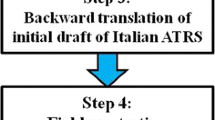Abstract
Purpose
The Achilles tendon Total Rupture Score (ATRS) was developed because of the need for a reliable, valid and sensitive instrument to evaluate symptoms and their effects on physical activity in patients following either conservative or surgical management of an Achilles tendon rupture. Prior to using the score in larger randomized trial in an English-speaking population, we decided to perform reliability, validity and responsiveness evaluations of the English version of the ATRS. Even though the score was published in English, the actual English version has not be validated and compared to the results of the Swedish version.
Methods
From 2009 to 2010, all patients who received treatment for Achilles tendon rupture were followed up using the English version of the ATRS. Patients were asked to complete the score at 3, 6 and 12 months following treatment for Achilles tendon rupture. The ATRS was completed on arrival in the outpatient clinic and again following consultation.
Results
The outcomes of 49 (13 female and 36 male) patients were assessed. The mean (SD) age was 49 (12) years, and 27 patients had treatment for a left-sided rupture, 22 the right. All patients received treatment for ruptured Achilles tendons: 38 acute percutaneous repair, 1 open repair, 5 an Achilles tendon reconstruction using a Peroneus Brevis tendon transfer for delayed presentation, 1 gracilis augmented repair for re-rupture and 4 non-operative treatment for mid-portion rupture. The English version of ATRS was shown to have overall excellent reliability (ICC = 0.986). There was no significant difference between the results with the English version and the Swedish version when compared at the 6-month- or 12-month (n.s.) follow-up appointments. The effect size was 0.93. The minimal detectable change was 6.75 points.
Conclusions
The ATRS was culturally adapted to English and shown to be a reliable, valid and responsive method of testing functional outcome following an Achilles tendon rupture.

Similar content being viewed by others
References
Carmont MR, Maffulli N (2008) Modified percutaneous repair of the Achilles tendon. Knee Surg Sports Traumatol Arthrosc 16:199–203
Carmont MR, Maffulli N (2007) Less invasive Achilles tendon reconstruction. BMC Musculoskelet Disord 8:100
Cetti R, Christiansen SE, Ejsted R et al (1993) Treatment of Achilles tendon rupture. A prospective randomised study and review of the literature. Am J Sports Med 21:791–799
Denegar CR, Ball DW (1993) Assessing reliability and precision measurement: an introduction to intraclass correlation and standard error of measurement. J Sport Rehab 2:35–42
Hopkins WG (2000) Measures of reliability in sports medicine and science. Sports Med 30:1–15
Kazis LE, Anderson JJ, Meenan RF (1989) Effect sizes for interpreting changes in health status. Med Care 27:S178–S189
Kearney RS, Achten J, Lamb SE, Parsons N, Costa ML (2012) The Achilles tendon Total Rupture Score: a study of responsiveness, internal consistency and convergent validity on patients with acute Achilles tendon ruptures. Health Qual Life Outcomes 10:24
Keating JF, Will EM (2011) Operative versus non-operative management of the acute rupture of the tendo Achillis: a prospective randomised evaluation of functional outcome. J Bone Joint Surg Br 8:1071–1078
Khan RJ, Fick D, Keogh A et al (2005) Treatment of acute Achilles tendon ruptures. A meta-analysis of randomized controlled trials. J Bone Joint Surg Am 87:2202–2210
Kitaoka HB, Alexander IJ, Adelaar RS et al (1994) Clinical rating systems for the ankle-hindfoot, midfoot, hallux and lesser toes. Foot Ankle Int 15:349–353
Leppilahti J, Orava S (1998) Total Achilles tendon rupture: a review. Sports Med 25:79–100
Leppilahti J, Forsman K, Puranen J et al (1998) Outcome and prognositic factors of Achilles rupture repair using a new scoring method. Clin Orthop Relat Res 346:152–161
Maffulli N, Wateston SW, Squair J et al (1999) Changing incidence of Achilles tendon rupture in Scotland: a 15 year study. Clin J Sport Med 9:157–160
Merkel M, Neumann HW, Merk H (1996) A new score for comparing outcome of surgical management of Achilles tendon ruptures. Chirug 67:1141–1146
Moller M, Movin T, Granhed H et al (2001) Acute rupture of the tendon Achillis. A prospective randomised study of comparison between surgical and non surgical treatment. J Bone Joint Surg Br 83:843–848
Nilsson-Helander K, Thomee R, Silbernagel KG et al (2007) The Achilles tendon Total Rupture Score (ATRS): development and validation. Am J Sports Med 35:421–426
Nilsson-Helander K, Silbernagel KG, Thomee R et al (2010) Acute Achilles tendon rupture: a randomized controlled study comparing surgical and non surgical treatments using validated outcome measure. Am J Sports Med 38:2186–2193
Nistor L (1981) Surgical and non-surgical treatment of Achilles tendon rupture. A prospective randomised study. J Bone Joint Surg Am 63:394–399
Olsson N, Nilsson-Helander K, Karlsson J et al (2011) Major functional deficits persist 2 years after acute Achilles tendon rupture. Knee Surg Sports Traumatol Arthrosc 19(8):1385–1393
Rohner-Spengler M, Mannion AF, Babst R (2007) Reliability and minimal detectable change for the figure-of-eight-20 method of, measurement of ankle edema. J Orthop Sports Phys Ther 37:199–205
Silbernagel KG, Nilsson-Helander K, Thomee R et al (2010) A new measurement of heel-rise endurance with the ability to detect functional deficits in patients with Achilles tendon rupture. Knee Surg Sports Traumatol Arthrosc 18:258–264
Thermann H (1996) Die funktionelle Behandlung der frischen Achillessehnen ruptur. Springer, Berlin
Wallace RG, Heyes GJ, Michael AL (2011) The non-operative functional management of patients with a rupture of the tendo Achillis leads to low rates of re-rupture. J Bone Joint Surg Br 93(10):1362–1366
Willits K, Amendola A, Bryant D et al (2010) Operative versus non-operative treatment of acute Achilles tendon ruptures: a multicenter randomized trail using accelerated functional rehabilitation. J Bone Joint Surg Am 92:767–775
Author information
Authors and Affiliations
Corresponding author
Rights and permissions
About this article
Cite this article
Carmont, M.R., Silbernagel, K.G., Nilsson-Helander, K. et al. Cross cultural adaptation of the Achilles tendon Total Rupture Score with reliability, validity and responsiveness evaluation. Knee Surg Sports Traumatol Arthrosc 21, 1356–1360 (2013). https://doi.org/10.1007/s00167-012-2146-8
Received:
Accepted:
Published:
Issue Date:
DOI: https://doi.org/10.1007/s00167-012-2146-8




